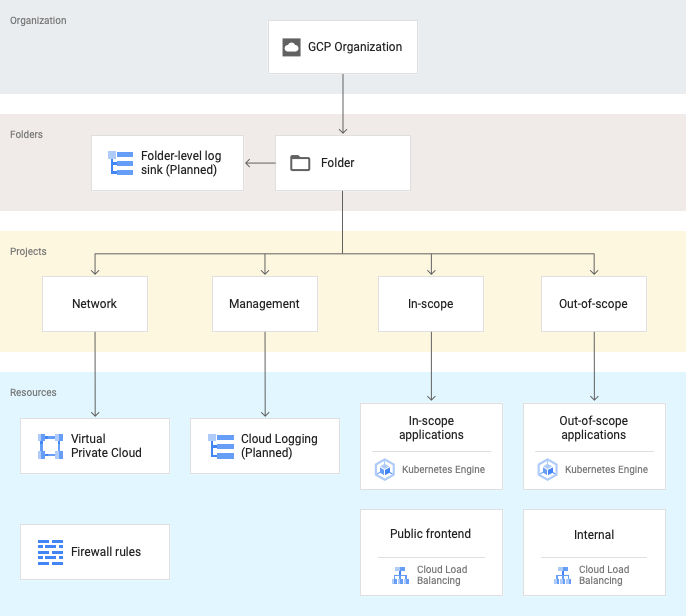This document contains detailed instructions for building this project's infrastructure.
This is a diagram illustrating the projects and the resources that will be created in them. Note that some of the resources, such as the load balancers, are not created until the application is deployed.
This diagram illustrates the networking and subnet details for the generated infrastructure.
After configuring your local environment as described in the workstation configuration section in the readme, the next step is to build the infrastructure that is required for deploying the application.
./_helpers/build-infra.shcontains all of the steps necessary to build the infrastructure needed before the application can be deployed. It's possible to run it directly as./_helpers/build-infra.sh. Alternatively, to follow along more in-depth, each command can be copied and pasted in the terminal as described here.
The first project to create is a special administrative project where Terraform resources are kept. The most important resource here will be the Cloud Storage bucket that will contain the Terraform state files.
To set up the admin resources run the following commands:
# Source the environment setup file you created previously
source workstation.env
# Create the Admin project
./_helpers/admin_project_setup.sh
The setup_service_account.sh script creates the terraform service account that will be used by terraform. Additionally, it provisions that service account with the permissions it will need for its operations. Run:
./_helpers/setup_service_account.shThe following line creates a backend.tf that points to the TF_ADMIN_BUCKET as defined in workstation.env and created previously in admin_project_setup.sh
cd terraform/infrastructure
sed "s/<SET TO THE VALUE OF TF_ADMIN_BUCKET>/${TF_ADMIN_BUCKET}/" terraform/infrastructure/backend.tf.example > terraform/infrastructure/backend.tf
Continuing from the terraform/infrastructure directory, the following are the commands needed to be run. Note that the final command includes the creation of all of the infrastructural components: projects, the shared-vpc network, as well as the two clusters, among other resources. It can take anywhere from 20-45 minutes to complete, when run for the first time.
terraform init
terraform plan -out terraform.out
terraform apply terraform.outAfter the above terraform apply, public DNS settings must be updated such that dig NS <frontend_zone_dns_name> from the terraform output equals the nameservers from the terraform output.
For example, from the output of "terraform apply":
frontend_zone_dns_name = a.example.com
nameservers = [
"ns-cloud-d1.googledomains.com.",
"ns-cloud-d2.googledomains.com.",
"ns-cloud-d3.googledomains.com.",
"ns-cloud-d4.googledomains.com.",
]
Using the appropriate DNS management method for your domain, update or create the NS record to match a.example.com as outputted by terraform. You can check by using dig should match:
$ dig +noall +answer NS a.example.com
a.example.com. 3600 IN NS ns-cloud-d4.googledomains.com.
a.example.com. 3600 IN NS ns-cloud-d2.googledomains.com.
a.example.com. 3600 IN NS ns-cloud-d3.googledomains.com.
a.example.com. 3600 IN NS ns-cloud-d1.googledomains.com.

